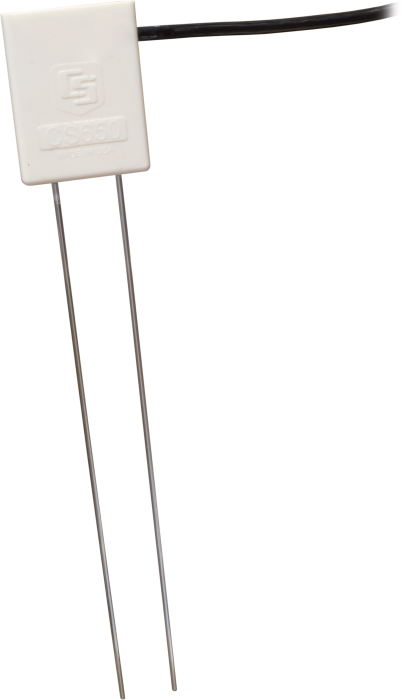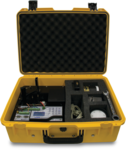
Mayor precisión en suelos con alta conductividad eléctrica






Resumen
El CS650 es un sensor inteligente multiparamétrico que usa innovadoras técnicas para monitorizar el contenido de agua volumétrico, conductividad eléctrica y temperatura del suelo. La señal de salida es digital SDI-12, compatible con la mayoría de nuestros dataloggers.
Leer másVentajas y características
- Medidas de contenido de agua más precisas en suelos con EC de hasta 3dSm-1 sin necesidad de una calibración específica del suelo
- Un mayor volumen de la muestra reduce el error
- Medida corregida para efectos de la textura del suelo y conductividad eléctrica
- Estima el contenido de agua del suelo para una amplia gama de suelos minerales
- Sensor versátil—mide la permitividad dieléctrica, conductividad eléctrica (EC), y temperatura del suelo
Imágenes



Descripción detallada
The CS650 consists of two 30-cm-long stainless steel rods connected to a printed circuit board. The circuit board is encapsulated in epoxy and a shielded cable is attached to the circuit board for datalogger connection.
The CS650 measures propagation time, signal attenuation, and temperature. Dielectric permittivity, volumetric water content, and bulk electrical conductivity are then derived from these raw values.
Measured signal attenuation is used to correct for the loss effect on reflection detection and thus propagation time measurement. This loss-effect correction allows accurate water content measurements in soils with bulk EC ≤3 dS m-1 without performing a soil specific calibration.
Soil bulk electrical conductivity is also calculated from the attenuation measurement. A thermistor in thermal contact with a probe rod near the epoxy surface measures temperature. Horizontal installation of the sensor provides accurate soil temperature measurement at the same depth as the water content. Temperature measurement in other orientations will be that of the region near the rod entrance into the epoxy body.
Productos similares
Preguntas frecuentes
Número de FAQs relacionadas con CS650: 50
Expandir todoDesplegar todo
-
The CS650 and CS655 work best when the rods are inserted into the soil as parallel to each other as possible. To make parallel pilot holes before installation, use the CS650G Rod Insertion Guide Tool. Minor deflection of a rod during insertion, such as when it contacts a small stone or root, may not affect the readings significantly, but major deflections may cause the CS650 or CS655 to operate outside of published accuracy specifications.
-
Probably not. The principle that makes these sensors work is that liquid water has a dielectric permittivity of close to 80, while soil solid particles have a dielectric permittivity of approximately 3 to 6. Because the permittivity of water is over an order of magnitude higher than that of soil solids, water content has a significant impact on the overall bulk dielectric permittivity of the soil. When the soil becomes very dry, that impact is minimized, and it becomes difficult for the sensor to detect small amounts of water. In air dry soil, there is residual water that does not respond to an electric field in the same way as it does when there is enough water to flow among soil pores. Residual water content can range from approximately 0.03 in coarse soils to approximately 0.25 in clay. In the natural environment, water contents below 0.05 indicate that the soil is as dry as it is likely to get. Very small changes in water content will likely cause a change in the sensor period average and permittivity readings, but, to interpret those changes, a very careful calibration using temperature compensation would need to be performed.
-
CS650 and CS655 sensors are read one at a time using SDI-12 commands. Consequently, they are never active at the same time and do not interfere with each other electrically. When installing the sensors close together, a general guideline is to keep them at least 10 cm apart.
-
Yes. There is surge protection built into the sensor electronics. The sensor survives a surge of 2 kV at 42 ohm line-to-ground on digital I/O and 2 kV at 12 ohm line-to-ground on power. It also survives a surge of 2 kV at 2 ohm line-to-ground on the rods.
If additional surge protection is required, consider using the SVP100 Surge Voltage Protector DIN Rail with Mounting Hardware.
-
Damage to the CS650 or the CS655 electronics or rods cannot be repaired because these components are potted in epoxy. Cable damage, on the other hand, may possibly be repaired. For more information, refer to the Repair and Calibration page.
-
The CS650 has rods that are 30 cm long, and the CS655 has rods that are 12 cm long. The difference in rod length causes some changes in specifications. For example, the CS650 is slightly more accurate in its permittivity and water content readings, but the CS655 works over a larger range of electrical conductivity. In addition, the CS650 handles a larger measurement volume and provides good accuracy in low EC (electrical conductivity) sand and sandy loam. The CS655 is typically more accurate in soil, works well over a wide range of soil textures and EC, and is easier to install because of its shorter rods.
-
In soil that is sandy, sandy loam, or loamy sand with low electrical conductivity, the CS650 is a suitable option because it has slightly better accuracy specifications than the CS655 and a larger measurement volume.
-
In soil that has a significant fraction of fines (loam, silt loam, silty clay loam, clay loam, clay), the CS655 is a suitable option because these soils tend to be more electrically conductive, and the CS655 operates over a larger range of electrical conductivity than the CS650. In applications where a smaller measurement volume is desired, such as larger greenhouse pots, the 12 cm long rods of the CS655 are preferable to the 30 cm long rods of the CS650.
-
The volumetric water content reading is the average water content over the length of the sensor’s rods.
-
The bulk electrical conductivity (EC) measurement is made along the sensor rods, and it is an average reading of EC over that distance at whatever depth the rods are placed.
Compatibilidad
Nota: lo siguiente muestra información de compatibilidad notable. No es una lista de todos los productos compatibles.
Dataloggers
| Producto | Compatible | Nota |
|---|---|---|
| CR1000 (retired) | ||
| CR1000X (retired) | ||
| CR300 (retired) | ||
| CR3000 (retired) | ||
| CR310 | ||
| CR350 | ||
| CR6 | ||
| CR800 (retired) | ||
| CR850 (retired) |
Información de compatibilidad adicional
RF Considerations
External RF Sources
External RF sources can affect the probe’s operation. Therefore, the probe should be located away from significant sources of RF such as ac power lines and motors.
Interprobe Interference
Multiple CS650 sensors can be installed within 4 inches of each other when using the standard datalogger SDI-12 “M” command. The SDI-12 “M” command allows only one probe to be enabled at a time.
Installation Tool
The CS650G makes inserting soil-water sensors easier in dense or rocky soils. This tool can be hammered into the soil with force that might damage the sensor if the CS650G were not used. It makes pilot holes into which the rods of the sensors can then be inserted.
Especificaciones
| Measurements Made | Soil electrical conductivity (EC), relative dielectric permittivity, volumetric water content (VWC), soil temperature |
| Required Equipment | Measurement system |
| Soil Suitability | Long rods with large sensing volume (> 6 L) are suitable for soils with low to moderate electrical conductivity. |
| Rods | Not replaceable |
| Sensors | Not interchangeable |
| Sensing Volume | 7800 cm3 (~7.5 cm radius around each probe rod and 4.5 cm beyond the end of the rods) |
| Electromagnetic |
CE compliant Meets EN61326 requirements for protection against electrostatic discharge and surge. |
| Operating Temperature Range | -50° to +70°C |
| Sensor Output | SDI-12; serial RS-232 |
| Warm-up Time | 3 s |
| Measurement Time | 3 ms to measure; 600 ms to complete SDI-12 command |
| Power Supply Requirements | 6 to 18 Vdc (Must be able to supply 45 mA @ 12 Vdc.) |
| Maximum Cable Length | 610 m (2000 ft) combined length for up to 25 sensors connected to the same data logger control port |
| Rod Spacing | 32 mm (1.3 in.) |
| Ingress Protection Rating | IP68 |
| Rod Diameter | 3.2 mm (0.13 in.) |
| Rod Length | 300 mm (11.8 in.) |
| Probe Head Dimensions | 85 x 63 x 18 mm (3.3 x 2.5 x 0.7 in.) |
| Cable Weight | 35 g per m (0.38 oz per ft) |
| Probe Weight | 280 g (9.9 oz) without cable |
Current Drain |
|
| Active (3 ms) |
|
| Quiescent | 135 µA typical (@ 12 Vdc) |
Electrical Conductivity |
|
| Range for Solution EC | 0 to 3 dS/m |
| Range for Bulk EC | 0 to 3 dS/m |
| Accuracy | ±(5% of reading + 0.05 dS/m) |
| Precision | 0.5% of BEC |
Relative Dielectric Permittivity |
|
| Range | 1 to 81 |
| Accuracy |
|
| Precision | < 0.02 |
Volumetric Water Content |
|
| Range | 0 to 100% (with M4 command) |
| Water Content Accuracy |
|
| Precision | < 0.05% |
Soil Temperature |
|
| Range | -50° to +70°C |
| Resolution | 0.001°C |
| Accuracy |
|
| Precision | ±0.02°C |
Documentos
Folletos producto
Documentos técnicos
Casos de aplicación
Casos de aplicación
Everglades National Park is the largest tropical wilderness in the United States and was created......leer más
Agrivoltaics or dual-use solar is a system combining an agricultural crop (viticulture, arboriculture, field crops,......leer más
Agrivoltaics or dual-use solar is a system combining an agricultural crop (viticulture, arboriculture, field crops,......leer más














